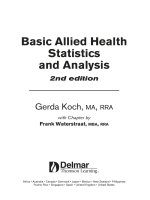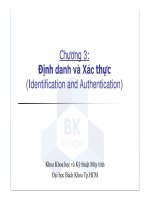Basic cardiac rhythms identification and response
Bạn đang xem bản rút gọn của tài liệu. Xem và tải ngay bản đầy đủ của tài liệu tại đây (5.24 MB, 210 trang )
Basic Cardiac
Rhythms –
Identification
and Response
Module 1
ANATOMY, PHYSIOLOGY, &
ELECTRICAL CONDUCTION
Objectives
▪ Describe the normal cardiac anatomy and physiology and normal
electrical conduction through the heart.
▪ Identify and relate waveforms to the cardiac cycle.
Cardiac Anatomy
▪ 2 upper chambers
▪ Right and left atria
▪ 2 lower chambers
▪ Right and left ventricle
▪ 2 Atrioventricular valves (Mitral &
Tricuspid)
▪ Open with ventricular diastole
▪ Close with ventricular systole
▪ 2 Semilunar Valves (Aortic & Pulmonic)
▪ Open with ventricular systole
▪ Open with ventricular diastole
The Cardiovascular System
▪ Pulmonary Circulation
▪ Unoxygenated – right side of the heart
▪ Systemic Circulation
▪ Oxygenated – left side of the heart
Anatomy
Coronary Arteries
How The Heart Works
Anatomy
Coronary Arteries
▪ 2 major vessels of the coronary circulation
▪ Left main coronary artery
▪ Left anterior descending and circumflex branches
▪ Right main coronary artery
▪ The left and right coronary arteries originate at the base of the
aorta from openings called the coronary ostia behind the aortic
valve leaflets.
Physiology
Blood Flow
Unoxygenated blood flows from
inferior and superior vena cava
Right Atrium
Tricuspid Valve
Right Ventricle
Pulmonic Valve
Lungs
Through Pulmonary system
Physiology
Blood Flow
Oxygenated blood flows from the
pulmonary veins
Left Atrium
Mitral Valve
Left Ventricle
Aortic Valve
Systemic Circulation
▪ Blood Flow Through The Heart
▪ Cardiology Rap
Physiology
▪ Cardiac cycle
▪ Represents the actual time sequence between ventricular contraction
and ventricular relaxation
▪ Systole
▪ Simultaneous contraction of the ventricles
▪ Diastole
▪ Synonymous with ventricular relaxation
▪ When ventricles fill passively from the atria to 70% of blood capacity
Physiology
▪ Heart rate (HR)
▪ Number of contractions (beats per minute)
▪ Normal heart rate is 60 – 100 beats per minute (bpm)
▪ Stroke volume (SV)
▪ Volume of blood being pumped out of ventricles in a single beat or
contraction
▪ Normal stroke volume is 60 – 130 mL
Physiology
▪ Cardiac output (CO)
▪ Amount of blood pumped by the left ventricle in one minute
▪ Normal cardiac output is 4 – 8 L/min
Cardiac Output =
Stroke Volume x Heart Rate
**Our Swan boxes give us a continuous cardiac output reading!
Physiology
▪ Pre-load
▪ Volume and stretch of the ventricular myocardium at the end of
diastole
▪ After-load
▪ Amount of pressure against which the left ventricle must work during
systole to open the aortic valve
▪ Clinically measure by systolic blood pressure
Normal Electrical Conduction System
SA node
Inter-nodal pathways
AV node
Bundle of his
Left & Right bundle branches
Purkinje fibers
The SA Node and the AV Node
Electrical Conduction System
EKG Waveforms
One complete cardiac cycle =
P, Q, R, S, (QRS complex),
and T wave
Electrical Conduction System
EKG Waveforms
▪ P wave
▪ Atrial depolarization (contraction)
▪ QRS Complex
▪ Ventricular depolarization, atrial repolarization
▪ T wave
▪ Ventricular repolarization (resting phase)
Module 2
INTERPRETING EKG
RHYTHM STRIPS
Objectives
▪ Utilize a systematic process when approaching the interpretation
of the EKG.
▪ Identify normal and abnormal components on the EKG.
EASI Lead
Lead Placement
Color Code
E Brown: Lower sternum (5th intercostal
space)
A Red: Left mid-axillary line (5th
intercostal space)
S Black: Upper sternum (just below sternal
angle)
I White: Right mid-axillary line (5th
intercostal space)
Green: Anywhere
Electrical Conduction Systems
EKG Waveforms
Reading EKG Graph Paper
Graph paper allows a visual
measurement of:
▪ Time (rate)
▪ Measured on the horizontal line
▪ Amplitude (voltage)
▪ Measured on the vertical line
Reading EKG Graph Paper
Paper divided into small squares:
▪ Width = 1 millimeter (mm)
▪ Time interval = 0.04 seconds
▪ 1 small square = 0.04 seconds
Reading EKG Graph Paper
Darker lines divide paper into every 5th
square vertically and horizontally:
▪ Large squares measure 5 mm in
height and width
▪ Represents time interval of 0.20 seconds
▪ 25 small squares in each large square
▪ 1 large square = 0.20 seconds
Interpreting EKG Rhythm Strips
▪ First and most important
▪ ASSESS YOUR PATIENT!!
▪ Read every strip from left to right, starting at the beginning of the
strip
▪ Apply the five-step systematic approach that you will learn in this
module for consistency with each strip that you interpret
Interpreting EKG Rhythm Strips
The Five Step Approach
The five-step approach, in order of application, includes analysis of
the following:
1. Heart rate
2. Heart rhythm
3. P wave
4. PR interval
5. QRS complex









